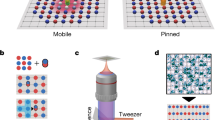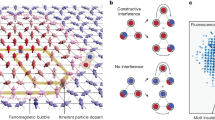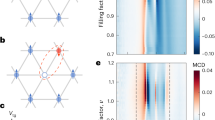Abstract
The emergence of quasiparticles in quantum many-body systems underlies the rich phenomenology in many strongly interacting materials. In the context of doped Mott insulators, magnetic polarons are quasiparticles that usually arise from an interplay between the kinetic energy of doped charge carriers and superexchange spin interactions1,2,3,4,5,6,7,8. However, in kinetically frustrated lattices, itinerant spin polarons—bound states of a dopant and a spin flip—have been theoretically predicted even in the absence of superexchange coupling9,10,11,12,13,14. Despite their important role in the theory of kinetic magnetism, a microscopic observation of these polarons is lacking. Here we directly image itinerant spin polarons in a triangular-lattice Hubbard system realized with ultracold atoms, revealing enhanced antiferromagnetic correlations in the local environment of a hole dopant. In contrast, around a charge dopant, we find ferromagnetic correlations, a manifestation of the elusive Nagaoka effect15,16. We study the evolution of these correlations with interactions and doping, and use higher-order correlation functions to further elucidate the relative contributions of superexchange and kinetic mechanisms. The robustness of itinerant spin polarons at high temperature paves the way for exploring potential mechanisms for hole pairing and superconductivity in frustrated systems10,11. Furthermore, our work provides microscopic insights into related phenomena in triangular-lattice moiré materials17,18,19,20.
This is a preview of subscription content, access via your institution
Access options
Access Nature and 54 other Nature Portfolio journals
Get Nature+, our best-value online-access subscription
$29.99 / 30 days
cancel any time
Subscribe to this journal
Receive 51 print issues and online access
$199.00 per year
only $3.90 per issue
Buy this article
- Purchase on Springer Link
- Instant access to full article PDF
Prices may be subject to local taxes which are calculated during checkout




Similar content being viewed by others
Data availability
Source data are provided with this paper and can be found in the Harvard Dataverse60. All other supporting data are available from the corresponding author upon request.
Code availability
The code used in this paper is available from the corresponding author upon request.
References
Brinkman, W. F. & Rice, T. M. Single-particle excitations in magnetic insulators. Phys. Rev. B 2, 1324 (1970).
Trugman, S. Interaction of holes in a Hubbard antiferromagnet and high-temperature superconductivity. Phys. Rev. B 37, 1597 (1988).
Kane, C., Lee, P. & Read, N. Motion of a single hole in a quantum antiferromagnet. Phys. Rev. B 39, 6880 (1989).
Auerbach, A. & Larson, B. E. Small-polaron theory of doped antiferromagnets. Phys. Rev. Lett. 66, 2262 (1991).
Grusdt, F. et al. Parton theory of magnetic polarons: mesonic resonances and signatures in dynamics. Phys. Rev. X 8, 011046 (2018).
Koepsell, J. et al. Imaging magnetic polarons in the doped Fermi–Hubbard model. Nature 572, 358–362 (2019).
Koepsell, J. et al. Microscopic evolution of doped Mott insulators from polaronic metal to Fermi liquid. Science 374, 82–86 (2021).
Ji, G. et al. Coupling a mobile hole to an antiferromagnetic spin background: transient dynamics of a magnetic polaron. Phys. Rev. X 11, 021022 (2021).
Haerter, J. O. & Shastry, B. S. Kinetic antiferromagnetism in the triangular lattice. Phys. Rev. Lett. 95, 087202 (2005).
Zhang, S.-S., Zhu, W. & Batista, C. D. Pairing from strong repulsion in triangular lattice Hubbard model. Phys. Rev. B 97, 140507 (2018).
Morera, I., Bohrdt, A., Ho, W. W. & Demler, E. Attraction from frustration in ladder systems. Preprint at https://arxiv.org/abs/2106.09600 (2021).
Morera, I. et al. High-temperature kinetic magnetism in triangular lattices. Phys. Rev. Res. 5, L022048 (2023).
Davydova, M., Zhang, Y. & Fu, L. Itinerant spin polaron and metallic ferromagnetism in semiconductor moiré superlattices. Phys. Rev. B 107, 224420 (2023).
Schlömer, H., Schollwöck, U., Bohrdt, A. & Grusdt, F. Kinetic-to-magnetic frustration crossover and linear confinement in the doped triangular t−J model. Preprint at https://arxiv.org/abs/2305.02342 (2023).
Nagaoka, Y. Ferromagnetism in a narrow, almost half-filled s band. Phys. Rev. 147, 392–405 (1966).
White, S. R. & Affleck, I. Density matrix renormalization group analysis of the Nagaoka polaron in the two-dimensional t−J model. Phys. Rev. B 64, 024411 (2001).
Tang, Y. et al. Simulation of Hubbard model physics in WSe2/WS2 moiré superlattices. Nature 579, 353–358 (2020).
Foutty, B. A. et al. Tunable spin and valley excitations of correlated insulators in Γ-valley moiré bands. Nat. Mater. 22, 731–736 (2023).
Ciorciaro, L. et al. Kinetic magnetism in triangular moiré materials. Nature 623, 509–513 (2023).
Tao, Z. et al. Observation of spin polarons in a frustrated moiré Hubbard system. Nat. Phys. https://doi.org/10.1038/s41567-024-02434-y (2024).
Keimer, B., Kivelson, S. A., Norman, M. R., Uchida, S. & Zaanen, J. From quantum matter to high-temperature superconductivity in copper oxides. Nature 518, 179–186 (2015).
Powell, B. & McKenzie, R. H. Quantum frustration in organic Mott insulators: from spin liquids to unconventional superconductors. Rep. Prog. Phys. 74, 056501 (2011).
Andrei, E. Y. & MacDonald, A. H. Graphene bilayers with a twist. Nat. Mater. 19, 1265–1275 (2020).
Mak, K. F. & Shan, J. Semiconductor moiré materials. Nat. Nanotechnol. 17, 686–695 (2022).
Georges, A., Kotliar, G., Krauth, W. & Rozenberg, M. J. Dynamical mean-field theory of strongly correlated fermion systems and the limit of infinite dimensions. Rev. Mod. Phys. 68, 13–125 (1996).
Anderson, P. W. et al. The physics behind high-temperature superconducting cuprates: the ‘plain vanilla’ version of RVB. J. Phys. Condens. Matter 16, R755 (2004).
Lee, P. A., Nagaosa, N. & Wen, X.-G. Doping a Mott insulator: physics of high-temperature superconductivity. Rev. Mod. Phys. 78, 17–85 (2006).
Mongkolkiattichai, J., Liu, L., Garwood, D., Yang, J. & Schauss, P. Quantum gas microscopy of fermionic triangular-lattice Mott insulators. Phys. Rev. A 108, L061301 (2023).
Xu, M. et al. Frustration-and doping-induced magnetism in a Fermi–Hubbard simulator. Nature 620, 971–976 (2023).
Chen, S. A., Chen, Q. & Zhu, Z. Proposal for asymmetric photoemission and tunneling spectroscopies in quantum simulators of the triangular-lattice Fermi–Hubbard model. Phys. Rev. B 106, 085138 (2022).
Samajdar, R. & Bhatt, R. N. Nagaoka ferromagnetism in doped Hubbard models in optical lattices. Preprint at https://arxiv.org/abs/2305.05683 (2023).
Lee, K., Sharma, P., Vafek, O. & Changlani, H. J. Triangular lattice Hubbard model physics at intermediate temperatures. Phys. Rev. B 107, 235105 (2023).
van de Kraats, J., Nielsen, K. K. & Bruun, G. M. Holes and magnetic polarons in a triangular lattice antiferromagnet. Phys. Rev. B 106, 235143 (2022).
Alexandrov, A. S. & Mott, N. F. Polarons and Bipolarons (World Scientific, 1996).
Bohrdt, A., Homeier, L., Reinmoser, C., Demler, E. & Grusdt, F. Exploration of doped quantum magnets with ultracold atoms. Ann. Phys. 435, 168651 (2021).
Sposetti, C. N., Bravo, B., Trumper, A. E., Gazza, C. J. & Manuel, L. O. Classical antiferromagnetism in kinetically frustrated electronic models. Phys. Rev. Lett. 112, 187204 (2014).
Hartke, T., Oreg, B., Turnbaugh, C., Jia, N. & Zwierlein, M. Direct observation of nonlocal fermion pairing in an attractive Fermi–Hubbard gas. Science 381, 82–86 (2023).
Yang, J., Liu, L., Mongkolkiattichai, J. & Schauss, P. Site-resolved imaging of ultracold fermions in a triangular-lattice quantum gas microscope. PRX Quantum 2, 020344 (2021).
Yamamoto, R., Ozawa, H., Nak, D. C., Nakamura, I. & Fukuhara, T. Single-site-resolved imaging of ultracold atoms in a triangular optical lattice. New J. Phys. 22, 123028 (2020).
Struck, J. et al. Quantum simulation of frustrated classical magnetism in triangular optical lattices. Science 333, 996–999 (2011).
Wei, D. et al. Observation of brane parity order in programmable optical lattices. Phys. Rev. X 13, 021042 (2023).
Trisnadi, J., Zhang, M., Weiss, L. & Chin, C. Design and construction of a quantum matter synthesizer. Rev. Sci. Instrum. 93, 083203 (2022).
Gross, C. & Bakr, W. S. Quantum gas microscopy for single atom and spin detection. Nat. Phys. 17, 1316–1323 (2021).
Preiss, P. M., Ma, R., Tai, M. E., Simon, J. & Greiner, M. Quantum gas microscopy with spin, atom-number, and multilayer readout. Phys. Rev. A 91, 041602 (2015).
Hartke, T., Oreg, B., Jia, N. & Zwierlein, M. Doublon–hole correlations and fluctuation thermometry in a Fermi–Hubbard gas. Phys. Rev. Lett. 125, 113601 (2020).
Koepsell, J. et al. Robust bilayer charge pumping for spin-and density-resolved quantum gas microscopy. Phys. Rev. Lett. 125, 010403 (2020).
Yan, Z. Z. et al. Two-dimensional programmable tweezer arrays of fermions. Phys. Rev. Lett. 129, 123201 (2022).
Varney, C. N. et al. Quantum Monte Carlo study of the two-dimensional fermion Hubbard model. Phys. Rev. B 80, 075116 (2009).
Merino, J., Powell, B. J. & McKenzie, R. H. Ferromagnetism, paramagnetism, and a Curie–Weiss metal in an electron-doped Hubbard model on a triangular lattice. Phys. Rev. B 73, 235107 (2006).
Morera, I., Weitenberg, C., Sengstock, K. & Demler, E. Exploring kinetically induced bound states in triangular lattices with ultracold atoms: spectroscopic approach. Preprint at https://arxiv.org/abs/2312.00768 (2023).
Zhu, Z., Sheng, D. & Vishwanath, A. Doped Mott insulators in the triangular-lattice Hubbard model. Phys. Rev. B 105, 205110 (2022).
Szasz, A., Motruk, J., Zaletel, M. P. & Moore, J. E. Chiral spin liquid phase of the triangular lattice Hubbard model: a density matrix renormalization group study. Phys. Rev. X 10, 021042 (2020).
Schrieffer, J., Wen, X.-G. & Zhang, S.-C. Spin-bag mechanism of high-temperature superconductivity. Phys. Rev. Lett. 60, 944 (1988).
Venderley, J. & Kim, E.-A. Density matrix renormalization group study of superconductivity in the triangular lattice Hubbard model. Phys. Rev. B 100, 060506 (2019).
Zampronio, V. & Macrì, T. Chiral superconductivity in the doped triangular-lattice Fermi–Hubbard model in two dimensions. Quantum 7, 1061 (2023).
Lebrat, M. et al. Observation of Nagaoka polarons in a Fermi–Hubbard quantum simulator. Nature https://doi.org/10.1038/s41586-024-07272-9 (2024).
Brown, P. T. et al. Spin-imbalance in a 2D Fermi–Hubbard system. Science 357, 1385–1388 (2017).
Tarruell, L., Greif, D., Uehlinger, T., Jotzu, G. & Esslinger, T. Creating, moving and merging Dirac points with a Fermi gas in a tunable honeycomb lattice. Nature 483, 302–305 (2012).
Assaad, F. F. et al. The ALF (Algorithms for Lattice Fermions) project release 2.0. Documentation for the auxiliary-field quantum Monte Carlo code. SciPost Phys. Codebases 1 https://doi.org/10.21468/SciPostPhysCodeb.1 (2022).
Prichard, M. et al. Replication data for: Directly imaging spin polarons in a kinetically frustrated Hubbard system. Harvard Dataverse https://doi.org/10.7910/DVN/ATI1FG (2023).
Acknowledgements
We acknowledge M. Greiner, D. Huse, R. Samajdar, L. Cheuk, E.-A. Kim, D. Khomskii, A. Bohrdt, F. Grusdt, H. Schlömer and G. Refael for discussions. We thank S. Dandavate for early assistance in performing the DQMC simulations. The experimental work was supported by the NSF (grant no. 2110475), the David and Lucile Packard Foundation (grant no. 2016-65128) and the ONR (grant no. N00014-21-1-2646). M.L.P. acknowledges support from the NSF Graduate Research Fellowship Program. E.D. acknowledges support from the ARO (grant no. W911NF-20-1-0163) and the SNSF (project 200021_212899). I.M. acknowledges support from grant no. PID2020-114626GB-I00 from the MICIN/AEI/10.13039/501100011033 and Secretaria d’Universitats i Recerca del Departament d’Empresa i Coneixement de la Generalitat de Catalunya, co-funded by the European Union Regional Development Fund within the ERDF Operational Program of Catalunya (project no. QuantumCat, Ref. 001-P-001644). I.M. and E.D. acknowledge support by the NCCR SPIN of the Swiss NSF.
Author information
Authors and Affiliations
Contributions
E.D., I.M. and W.S.B. conceived the study and supervised the experiment. M.L.P., B.M.S. and Z.Z.Y. performed the experiments and analysed the data. All authors contributed to writing the paper.
Corresponding author
Ethics declarations
Competing interests
The authors declare no competing interests.
Peer review
Peer review information
Nature thanks Georg Bruun, Jae-yoon Choi and Zheng Zhu for their contribution to the peer review of this work.
Additional information
Publisher’s note Springer Nature remains neutral with regard to jurisdictional claims in published maps and institutional affiliations.
Extended data figures and tables
Extended Data Fig. 1 Superlattice Phase Calibration.
P-band spectroscopy used to calibrate the superlattice phase and stability. The dips at 292 MHz and 340 MHz superlattice detuning correspond to ϕ = 3π/2 and ϕ = π/2. Fitted peaks (solid lines) are at [292.4(6) MHz, 339.8(8) MHz] and [292.6(8) MHz, 341.0(8) MHz] for the red and blue data respectively. Callout fluoresence images show the expansion of a Mott insulator after 1 second for superlattice phase ϕ = π (top) and ϕ = 0 (bottom) at V752 = 42.0(3)ER,752 and V532 = 3.7(1)ER,532. Inset: Experimental setup used for realizing the optical superlattice.
Extended Data Fig. 2 Bilayer Image Reconstruction.
Sample deconvolved experimental images and occupation histograms for state \(\left|3\right\rangle \) (top, red) and state \(\left|2\right\rangle \) (bottom, blue) atoms. We use the Lucy-Richardson algorithm with five iterations for the deconvolution.
Extended Data Fig. 3 Multi-point Correlations at Different Global Chemical Potentials.
a, \({C}_{h}^{(3)}\) (red data) and \({C}_{d}^{(3)}\) (green data) evaluated at the bond closest to the dopant, and b, C(4) for two different datasets with distinct global chemical potentials. As these two datasets track each other well, particularly at low filling, we conclude spatial gradients do not appreciably suppress resonant tunneling to affect measured correlations. Filled data points have mean atom number 799(35) while empty data points have mean atom number 622(27).
Extended Data Fig. 4 Interaction Dependence of Four-point Correlations.
Four-point correlations vs. doping for different interaction strengths U/t = 8.0(2) (open circles) and U/t = 11.8(4) (filled circles).
Extended Data Fig. 5 Unsymmetrised Correlations versus Distance.
\({C}_{h}^{(3)}\) for δ = −0.10(2) and \({C}_{d}^{(3)}\) for δ = 0.15(2) out to d = (2, 0) without averaging over the 120 degree rotational symmetry.
Extended Data Fig. 6 Unsymmetrised Correlations versus Doping.
\({C}_{h}^{(3)}\) and \({C}_{d}^{(3)}\) for different dopings at a U/t = 11.8 without averaging over all six individual plaquettes. We see that unsymmetrised correlations are largely consistent between different orientations. Error bars are 1 s.e.m.
Extended Data Fig. 7 Doublon Density versus Doping.
Number of measured doubles (red points) and theoretical expected number of doubles from DQMC (red band) with imaging fidelity of 0.96 accounted for at U/t = 11.8(4), T/t = 0.94(4). The highest doping bin (δ = 0.15) has around 20 percent more, the second highest doping bin (δ = 0.12 has around 10 percent more, and the third highest doping bin (δ = 0.08) has around 5 percent more doubles than predicted. We believe this is caused by image reconstruction errors and leads to a systematic underestimate of certain three and four point correlators above zero doping. This qualitative trend appears for all three interaction strengths. Error bars are 1 s.e.m.
Extended Data Fig. 8 Three-point Correlations Temperature Dependence.
DQMC results for C(3) evaluated at the closest bond to the dopant versus doping at a fixed U/t = 12 and different temperatures. All temperature curves have the same qualitative trend with the \({C}_{h}^{(3)}\) minimum at a doping of ~ −0.3 and the \({C}_{d}^{(3)}\) maximum at a doping of ~0.15 with a linear region near zero doping. Decreasing T/t of the gas from 0.95 to 0.65 causes the magnitude of the peak values of C(3) to increase by roughly fifty percent. An imaging fidelity of 0.96 is assumed.
Extended Data Fig. 9 Doublon Correlations versus Temperature.
\({C}_{d}^{(3)}\) calculated at δ = 0.02 for U/t = 12 at three different temperatures using DQMC. As the temperature decreases, the magnitude of the farther correlations increases slightly while there are no major qualitative differences in the structure of the correlations; the size of the polaron does not have a strong dependence on the temperature.
Extended Data Fig. 10 Three-point Correlations Interaction Dependence.
DQMC results for C(3) evaluated at the closed bond to the dopant versus doping at fixed T/t = 0.85 and different interaction strengths. We see that for all interaction strengths the \({C}_{h}^{(3)}\) minimum is at a doping of ~ −0.3 and the \({C}_{d}^{(3)}\) maximum is at a doping of ~0.15 for the two higher interaction strengths, while for U/t = 4 the peak appears slightly closer to zero doping. The two higher doping curves have roughly the same peak C(3) magnitudes, while for U/t = 4 the peaks are roughly 10 percent lower. However, we see that qualitatively the curves are quite different close to half filling, where as U/t increases the onset of \({C}_{h}^{(3)}\) and \({C}_{d}^{(3)}\) with doping becomes sharper, leading to a region where the \({C}_{h}^{(3)}\) is linear below zero doping and \({C}_{d}^{(3)}\) is linear above zero doping. An imaging fidelity of 0.96 is assumed.
Source data
Rights and permissions
Springer Nature or its licensor (e.g. a society or other partner) holds exclusive rights to this article under a publishing agreement with the author(s) or other rightsholder(s); author self-archiving of the accepted manuscript version of this article is solely governed by the terms of such publishing agreement and applicable law.
About this article
Cite this article
Prichard, M.L., Spar, B.M., Morera, I. et al. Directly imaging spin polarons in a kinetically frustrated Hubbard system. Nature 629, 323–328 (2024). https://doi.org/10.1038/s41586-024-07356-6
Received:
Accepted:
Published:
Issue Date:
DOI: https://doi.org/10.1038/s41586-024-07356-6
This article is cited by
Comments
By submitting a comment you agree to abide by our Terms and Community Guidelines. If you find something abusive or that does not comply with our terms or guidelines please flag it as inappropriate.



